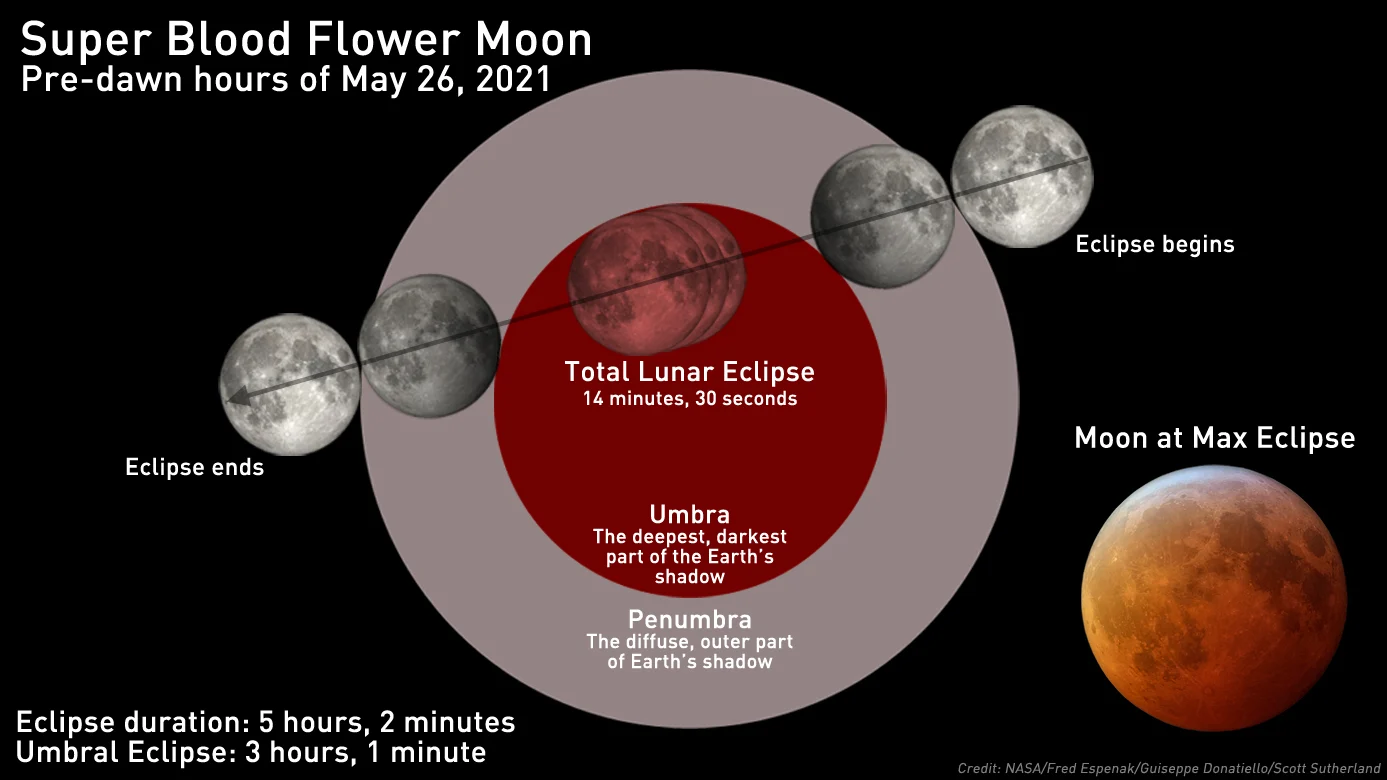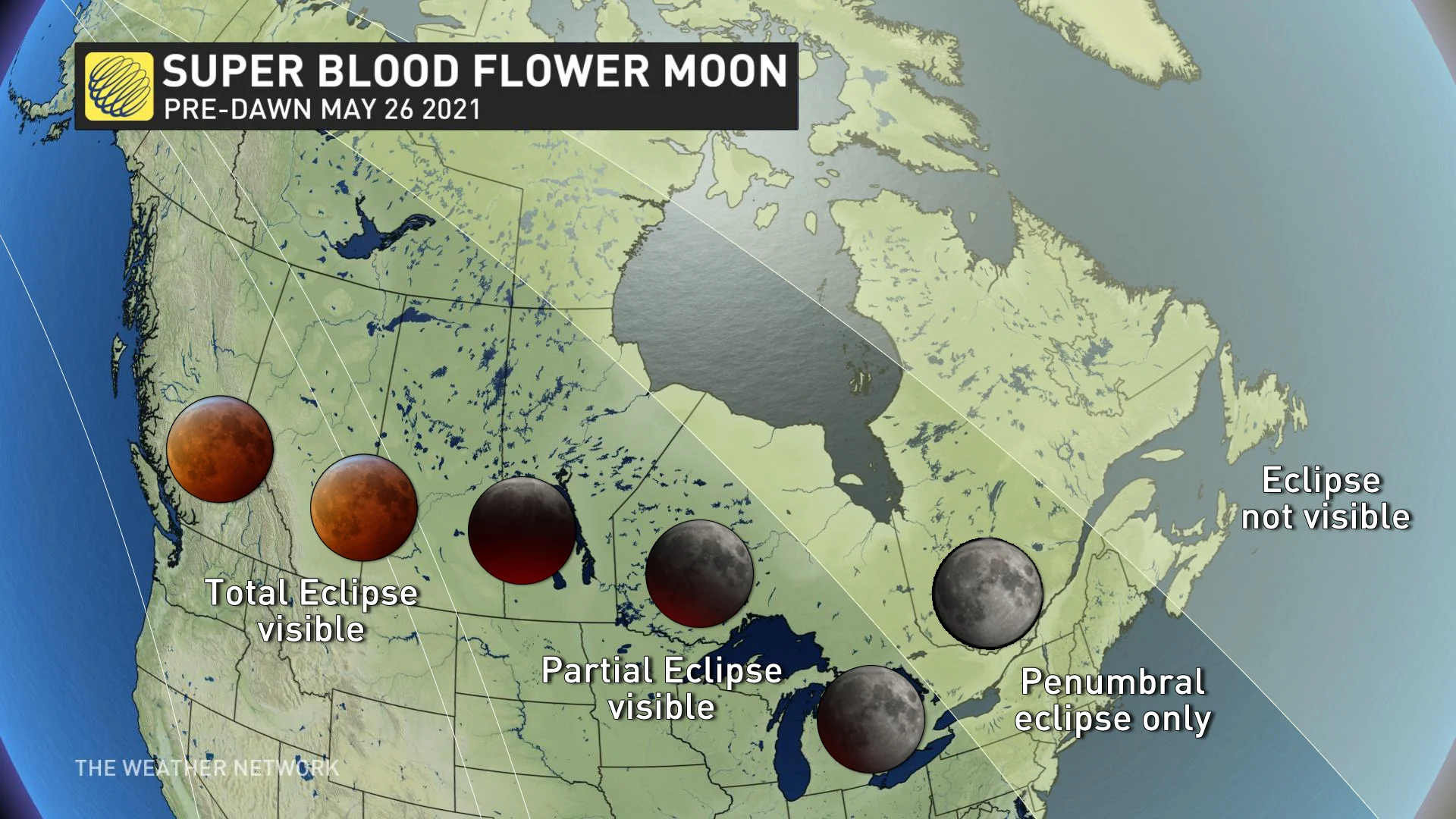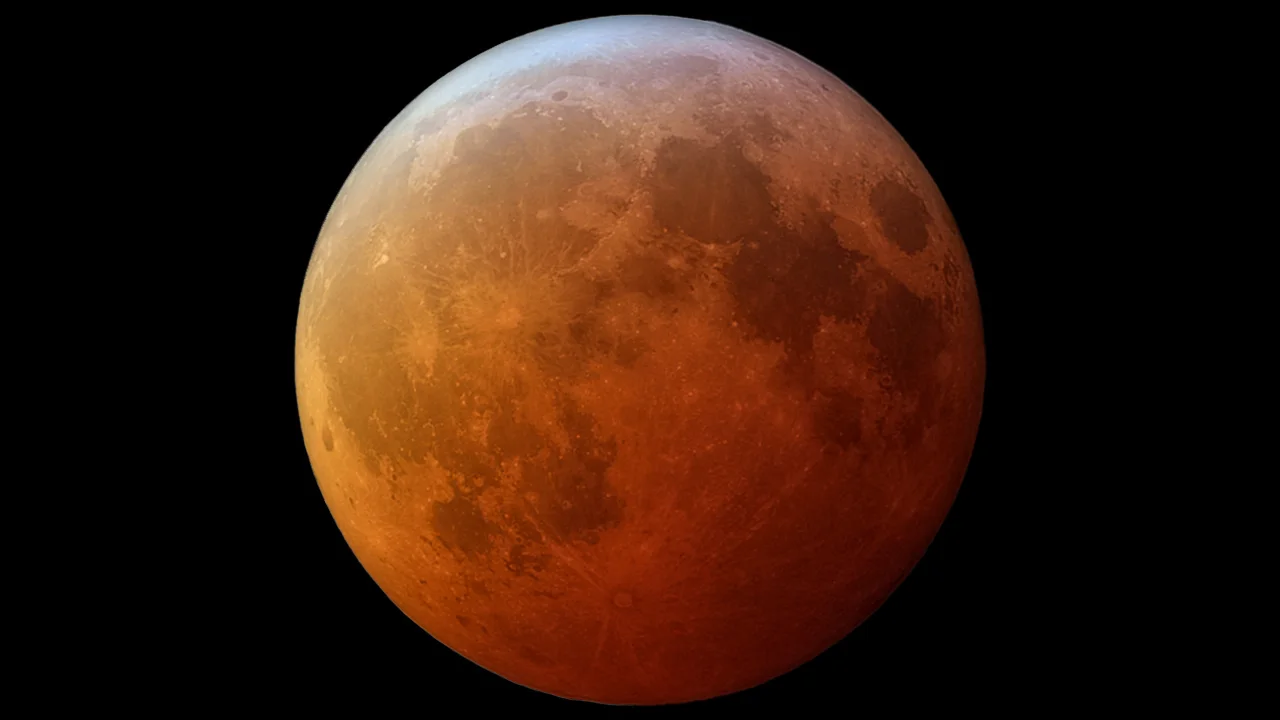
How to watch the upcoming Super Blood Flower Moon total lunar eclipse
This is the last supermoon total lunar eclipse for more than a decade, and Western Canada is particularly well-positioned to see it!
A total lunar eclipse will be visible across parts of Canada, Wednesday morning. Here's how to watch this spectacular astronomical event.
A supermoon will be up in the sky throughout the night from Tuesday into Wednesday this week, but early in the morning on Wednesday May 26, 2021, we'll see something special. The Sun, Earth, and Moon will line up perfectly to produce a perigee total lunar eclipse — the Super Blood Flower Moon.
Very similar to 2019's Super Blood Wolf Moon, this is a supermoon, meaning that the Full Moon is occurring when the Moon is at the closest point to Earth in its orbit. It's a 'blood moon' because the Moon turns red during the eclipse. The only difference for the name is that the Wolf Moon is January's Full Moon. May's Full Moon is commonly known as the Flower Moon.

The path of the Full Flower Moon through Earth's shadow during the May 26 total lunar eclipse. Credit: NASA/Fred Espenak/Guiseppe Donatiello/Scott Sutherland.
The name may not be as catchy, but this is a special lunar eclipse. At just 357,453 km from Earth at the time, the Moon will actually be slightly closer, and thus will appear slightly larger and brighter than the 'blood moon' than we saw in 2019. Also, this will be the last supermoon total lunar eclipse for more than a decade. While there are several total lunar eclipses in the years ahead, the next definite supermoon total lunar eclipse looks to be the Super Blood Harvest Moon in October of 2033.
There's one unfortunate part of this event, though. Most Canadians will completely miss it.
While the January 2019 eclipse was visible from coast to coast across Canada, Wednesday's Super Blood Flower Moon will only be experienced to its fullest from Western Canada. Some regions of the country, like Atlantic Canada, Quebec and parts of Ontario, won't even see it at all. Don't despair, though. Read on for tips on how to watch it, no matter where you are.
WILL YOU SEE IT FOR YOURSELF?
Assuming that the weather cooperates, here's the full guide on when to watch, based on where you are in Canada.

Sunrise and moonset will end the event early for eastern regions of Canada, in some places before it even starts.
Newfoundland and Labrador, Nova Scotia, PEI, New Brunswick and eastern Nunavut: Sorry, the eclipse will not be visible from your location. But read on to see how you can watch online!
Quebec, Eastern and Northern Ontario, western Nunavut, northern Northwest Territories and Yukon: Penumbral eclipse begins at 4:47 a.m. EDT, and depending on where you are watching from, the Moon will set between 15-45 minutes later:
5:02 a.m. EDT in Quebec City
5:16 a.m. EDT in Montreal
5:25 a.m. EDT in Ottawa
5:33 a.m. EDT in Kingston
5:38 a.m. EDT in North Bay
5:44 a.m. EDT in Sudbury
However, given how difficult it is to notice a penumbral eclipse, even when the Moon is high above the horizon, it will be even harder to see when the Moon is so low in the sky.
Southwestern Ontario, including the Greater Toronto Area: the penumbral eclipse starts at 4:47 a.m. EDT, and the Moon will just be starting its transition into the umbra at 5:44 a.m. EDT. For the GTA, that is just around the same time as the Moon will be setting, thus viewers will likely see some darker shading on one edge of the Moon just as it is slipping below the horizon. Those closer to London and Windsor will see a bit more of the partial eclipse before they lose sight of the Moon. Moonset is at:
5:46 a.m. EDT for Toronto and the GTA
5:56 a.m. EDT in London
6:05 a.m. EDT in Windsor
From western Ontario to Regina, SK, northeastern Alberta, central Northwest Territories and Yukon: the partial eclipse starts at 4:47 a.m. EDT, 3:47 a.m. CDT, or 2:47 a.m. CST/MDT, depending on your local time zone, with the transition into the umbra starting roughly one hour later. For best results, definitely start watching by 5:44 a.m. EDT/4:44 a.m. CDT/3:44 a.m. CST/MDT. The Moon will set at:
6:10 a.m. EDT in Thunder Bay
5:37 a.m. CDT in Winnipeg
5:05 a.m. CST in Regina
5:06 a.m. CST in Saskatoon
5:00 a.m. MDT in Fort McMurray
4:26 a.m. MDT in Yellowknife
Note: While it will appear as though a great shadow is falling over the Moon, picking out the dusky red colour of the umbra will be difficult without a telescope and a good camera. For Regina and Saskatoon (and surrounding areas) moonset is roughly 5-6 minutes before the Moon is fully immersed in the umbra, so it will be easier to pick out the reddish tinge.
Southwestern Saskatchewan and Alberta: the entire first half of the eclipse will be visible, from the Moon entering the penumbra at 2:47 a.m. CST/MDT, transitioning into the umbra starting at 3:44 a.m. CST/MDT, to it being completely immersed in the umbra by 5:11 a.m. CST/MDT. How long a viewer sees the total eclipse will depend on when the Moon sets:
5:19 a.m. CST in Swift Current, SK
5:26 a.m. MDT in Edmonton
5:31 a.m. MDT in Alix
5:41 a.m. MDT in Calgary
5:42 a.m. MDT in Lethbridge
The total eclipse lasts for 14 minutes and 30 seconds. Thus, viewers in much of Alberta will see the best part of the eclipse, and then get to watch the Moon transition back into the penumbra.
British Columbia and southern Yukon: will have the best views of all for Canada. The penumbral eclipse begins at 1:47 a.m. PDT, and the umbra eclipse (the best time to start watching) starts at 2:44 a.m. PDT. The Moon is fully immersed in the umbra starting at 4:11 a.m. PDT, reaches maximum eclipse at 4:18 a.m. PDT, and starts its exit from the umbra at 4:25 a.m. PDT. From there, how much of the Moon exiting the umbra before it sets depends on your location. Moonset is at:
5:02 a.m. PDT in Prince George
5:06 a.m. PDT in Whitehorse
5:08 a.m. PDT in Kelowna and Kamloops
5:10 a.m. PDT in Penticton
5:26 a.m. PDT in Vancouver
5:30 a.m. PDT in Victoria

This image combines a view of the January 2019 Super Blood Wolf Moon with the exact phase and appearance of the Moon on the morning of May 26 from NASA, to give an approximation of how the Super Blood Flower Moon will look. Credit: NASA's Scientific Visualization Studio/Guiseppe Donatiello/Scott Sutherland
HOW TO WATCH FROM ANYWHERE
If you can't see the Super Blood Flower Moon for yourself, due to either the weather or just not being in the right location at the time, there are still options.
The event will be live-streamed on the internet, and while there will undoubtedly be a number of different streams to watch, one of the best will be from the Griffith Observatory in Los Angeles. Their livestream, embedded below, begins at 4:45 a.m. EDT on the morning of May 26.
As this eclipse is timed to be centred over the Pacific Ocean, the telescopes at the Mauna Kea Observatory in Hawai'i are expected to have the best view of all. Viewers there will be able to watch the entire event, from start to finish.






